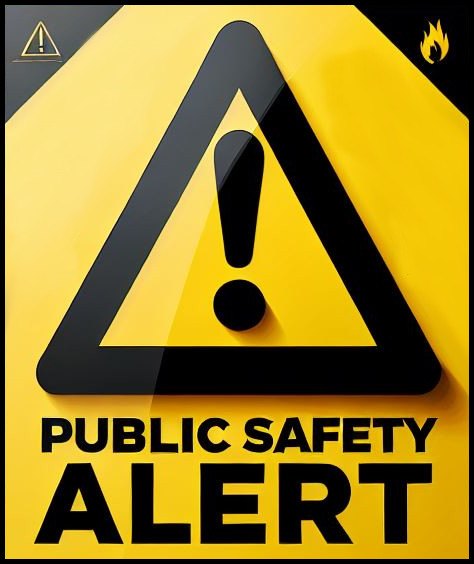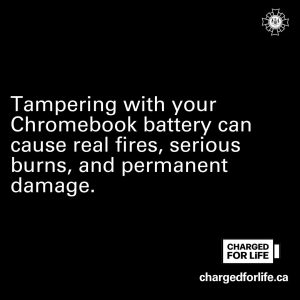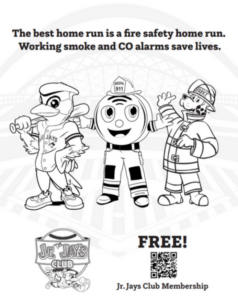Latest:
-
“Chromebook Challenge” – Dangerous New Viral Challenge in Schools
The Office of the Fire Marshal is spreading the word about an alarming trend spreading across social media and our schools. This new viral challenge is seeing students purposely tampering with their school supplied Chromebooks and laptops in an attempt to cause the device to short-circuit and stop functioning.
While this may seem like a harmless joke to get out of school work, it can quickly become a dangerous and even life threatening situation. With these devices containing lithium-ion batteries, short circuiting or damaging the electronic components can quickly lead to the devices and their batteries overheating or catching fire, making it far more serious than a simple joke.
When a lithium-ion battery is damaged in such a manor, it can easily catch fire on it’s own and enter what is called “thermal runaway.” This means the battery will burn hotter and faster, creating its own fuel and oxygen to continue burning, and can be incredibly hard to extinguish. The fires caused can quickly spread through the intense heat, and the gases produced are incredibly toxic. The damages created by this type of fire can be extensive, not to mention dangerous to health and life.
This is about more than just a joke, or tech misuse, or getting out of class early. This is about kids safety in schools, about the consequences of intentionally starting a fire and the cost of the damages, and about stopping a silly trend before it takes lives.
Talk to your kids or students about lithium-ion battery safety, and the dangers of potentially starting a fire at school or home. Going viral on TikTok is not worth the potential damages, or loss of life.
For more lithium-ion battery safety advice, visit the Charged For Life website.
-
A Home Run for Fire Safety!
The Fire Marshal’s Public Fire Safety Council is pleased to announce an exciting new partnership with the Toronto Blue Jays! Together, with the help of local fire departments, we hope to spread the word about fire safety messaging across Ontario in a Big-League way!
As part of the partnership, the Toronto Blue Jays donated one million printed fire safety colouring sheets distributed by the FMPFSC to all Ontario Fire Departments. These colouring pages have been given out to local restaurants for kids to enjoy while eating out at their favorite spots. The colouring pages include the beloved mascots “Ace” from the Toronto Blue Jays, “Sparky” the fire dog from the NFPA, and “Beepa” Ontario’s very own FMPFSC mascot!
You can find these colouring pages at the following local restaurants:
- Bancroft Brew Pub
- Dave’s Place Restaurant
- Eagles Nest Restaurant
- Fiesta Flavors
- For the Halibut
- The Granite
- McG’s Cakes on Main
- Vito’s Pizzeria
- Wattle & Daub Cafe
A Big-League thanks to our local restaurants for helping to support such a great cause and spread the message of fire safety!!
-
When Every Second Counts – Know When To Call
The Importance of Using 911 Properly
In times of crisis, knowing how to use emergency services effectively can make a significant difference. The 911 system is a critical lifeline designed to provide immediate assistance during emergencies. However, it’s essential to understand the importance of using 911 properly and to avoid making non-emergency or nuisance calls. Additionally, being aware of your local non-emergency phone numbers can help ensure that emergency services remain available for those who truly need them.

Why Proper Use of 911 Matters
- Saving Lives: The primary purpose of 911 is to save lives. When you call 911, you are connected to trained professionals who can dispatch police, fire, or medical services to your location quickly. Misusing this service can delay help for someone in a genuine emergency.
- Efficient Resource Allocation: Emergency services have limited resources. Non-emergency calls can tie up these resources, preventing them from being available for real emergencies. This can lead to slower response times and potentially tragic outcomes.
- Legal Consequences: Making false or prank calls to 911 is illegal and can result in severe penalties, including fines and imprisonment. It’s important to understand that these actions are taken seriously and can have long-lasting consequences.
What Constitutes a 911 Emergency?
A 911 emergency is any situation that requires immediate assistance from the police, fire department, or medical services. Examples include:
- Fires
- Crimes in prgress
- Serious car accidents
- Medical emergencies (eg., heart attach, severe injury)
If you are unsure whether your situation is an emergency, it’s better to err on the side of caution and call 911. The dispatcher can help determine if emergency services are needed.
Avoiding Non-Emergency Calls
Non-emergency situations should be directed to local non-emergency phone numbers. These can include:
- Noise complaints
- Minor car accidents without injuries
- Lost or found property
- General inquiries about local services
Knowing your local non-emergency numbers can help keep 911 lines open for true emergencies. Many communities provide these numbers on their official websites or through local government offices.
How to Find Your Local Non-Emergency Numbers
Department Non-Emergency Number Website Bancroft O.P.P. Detachment 613-332-2112 www.opp.ca Town of Bancroft 613-332-3331 www.bancroft.ca Bancroft Fire Department 613-332-2442 www.bancroftfire.ca Municipality of Hastings Highlands 613-338-2811 www.hastingshighlands.ca Hastings Highlands Fire Dept. 613-338-2811 Ext 313 www.hastingshighlands.ca Faraday Township 613-332-3638 www.faraday.ca Faraday Fire Department 613-332-3638 www.faraday.ca Limerick Township 613-474-0478 www.limerick.ca Limerick Fire Department 613-332-8898 www.limerick.ca Wollaston Township 613-337-5731 www.wollaston.ca Wollaston Fire Department 613-337-5731 www.wollaston.ca Using 911 properly is crucial for the safety and well-being of everyone in the community. By reserving 911 for true emergencies and utilizing local non-emergency numbers for other situations, you can help ensure that emergency services are available when they are needed most. Remember, your actions can make a difference in saving lives and maintaining public safety.
Latest Posts:



